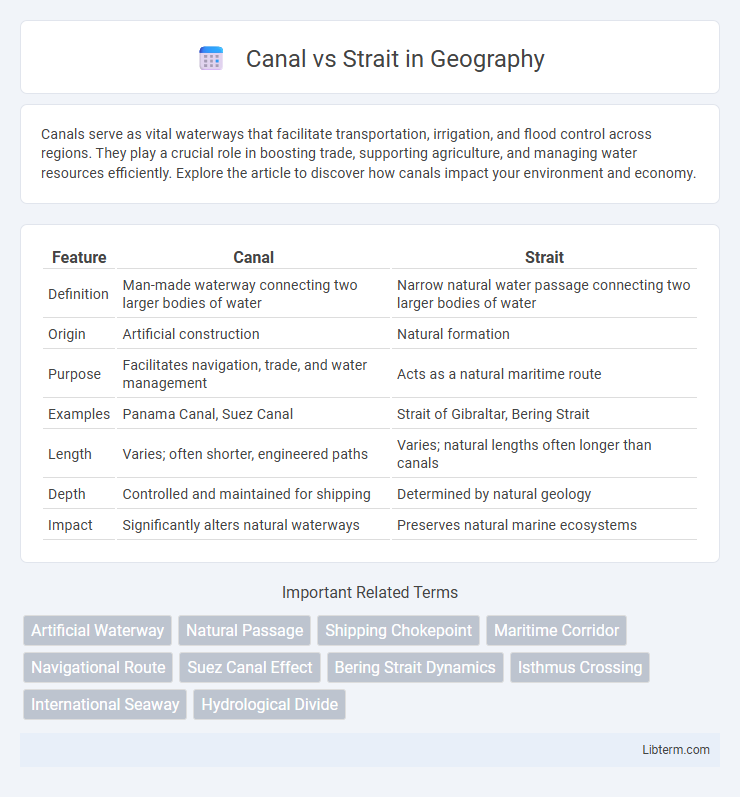Canals serve as vital waterways that facilitate transportation, irrigation, and flood control across regions. They play a crucial role in boosting trade, supporting agriculture, and managing water resources efficiently. Explore the article to discover how canals impact your environment and economy.
Table of Comparison
| Feature | Canal | Strait |
|---|---|---|
| Definition | Man-made waterway connecting two larger bodies of water | Narrow natural water passage connecting two larger bodies of water |
| Origin | Artificial construction | Natural formation |
| Purpose | Facilitates navigation, trade, and water management | Acts as a natural maritime route |
| Examples | Panama Canal, Suez Canal | Strait of Gibraltar, Bering Strait |
| Length | Varies; often shorter, engineered paths | Varies; natural lengths often longer than canals |
| Depth | Controlled and maintained for shipping | Determined by natural geology |
| Impact | Significantly alters natural waterways | Preserves natural marine ecosystems |
Definition of Canal and Strait
A canal is an artificial waterway constructed to allow the passage of boats or ships, often connecting two larger bodies of water and facilitating navigation or irrigation. A strait is a naturally occurring narrow water passage that connects two larger bodies of water and lies between two land masses. Both serve as critical maritime routes, but canals are man-made, while straits are natural formations.
Key Differences Between Canals and Straits
Canals are man-made waterways constructed to facilitate transportation, irrigation, or drainage, whereas straits are natural narrow passages of water connecting two larger bodies of water. Canals often feature locks and controlled water flow, enabling navigation across varying elevations, while straits have natural currents and tides influenced by surrounding marine conditions. The strategic and commercial significance of canals is enhanced by human engineering, whereas straits hold ecological and geopolitical importance due to their natural formation and location.
Historical Significance of Canals and Straits
Canals like the Suez and Panama have historically transformed global trade routes by providing engineered waterways that shorten maritime distances and boost economic connectivity between continents. Straits such as Gibraltar and Malacca have served as critical natural chokepoints for naval strategy and commerce, shaping the control and power dynamics of empires throughout history. The strategic importance of both canals and straits lies in their ability to influence geopolitical relationships and facilitate the flow of goods, military forces, and cultural exchange.
Major Canals Around the World
Major canals around the world, such as the Panama Canal, Suez Canal, and Kiel Canal, play crucial roles in global maritime trade by connecting large bodies of water and significantly reducing shipping routes. The Panama Canal links the Atlantic and Pacific Oceans, the Suez Canal connects the Mediterranean Sea to the Red Sea, and the Kiel Canal facilitates passage between the North Sea and the Baltic Sea, bypassing the longer route around Denmark's Jutland Peninsula. These man-made waterways differ from straits, which are natural narrow passages of water between two land masses.
Famous Straits and Their Importance
Famous straits such as the Strait of Hormuz, the Bering Strait, and the Strait of Gibraltar serve as critical maritime chokepoints, facilitating global trade and strategic military movements. The Strait of Hormuz, located between the Persian Gulf and the Gulf of Oman, is vital for oil transportation, with about 20% of the world's petroleum passing through it daily. The strategically significant Strait of Gibraltar connects the Atlantic Ocean to the Mediterranean Sea, serving as a gateway for naval traffic and commerce.
Strategic and Economic Roles
Canals such as the Panama Canal provide controlled, man-made waterways that significantly reduce shipping distances and transit times, enhancing global trade efficiency and economic connectivity between major markets. Straits like the Strait of Hormuz serve as critical chokepoints for international maritime traffic, especially for energy exports, controlling strategic access between vital bodies of water and impacting global energy security. Both canals and straits hold immense strategic value by influencing naval mobility and economic flow, directly affecting the geopolitical stability of the surrounding regions.
Environmental Impact of Canals and Straits
Canals often cause significant environmental disruption due to dredging, water flow alteration, and habitat fragmentation, which can lead to loss of biodiversity and changes in local ecosystems. Straits, as natural waterways, typically maintain existing ecological balances but may experience increased pollution and invasive species introduction from heavy marine traffic. Both canals and straits require careful management to minimize ecological damage, especially concerning water quality, sediment transport, and marine life migration.
Engineering Challenges and Innovations
Canals require extensive engineering to create artificial waterways, involving excavation, water management systems, and lock construction to accommodate varying elevations and maintain navigability. Straits, being natural narrow passages between land masses, pose different challenges such as managing strong currents, sedimentation, and ensuring safe navigation through natural geological constraints. Innovations in canal engineering include advanced lock mechanisms and automated water control systems, while strait navigation benefits from technologies like dynamic positioning and real-time hydrodynamic monitoring to enhance maritime safety and efficiency.
Navigation and Maritime Regulations
Canals are man-made waterways designed to facilitate controlled navigation, often equipped with locks and regulated traffic systems to manage vessel movement and ensure safety. Straits are natural narrow passages between two landmasses where maritime regulations prioritize international navigation rights, environmental protection, and security under conventions like the United Nations Convention on the Law of the Sea (UNCLOS). Both canals and straits require compliance with specific maritime rules, but canals may impose more stringent operational controls due to their engineered infrastructure and commercial significance.
Future Developments in Waterway Infrastructure
Future developments in waterway infrastructure emphasize enhancing canal capacity and incorporating smart technology to manage traffic efficiently, reducing congestion and environmental impact. Straits, often constrained by natural geography, are seeing increased international cooperation to improve navigational safety and expand nearby port facilities. Investment in sustainable construction materials and AI-powered monitoring systems aims to future-proof both canals and straits for growing global maritime trade demands.
Canal Infographic

 libterm.com
libterm.com